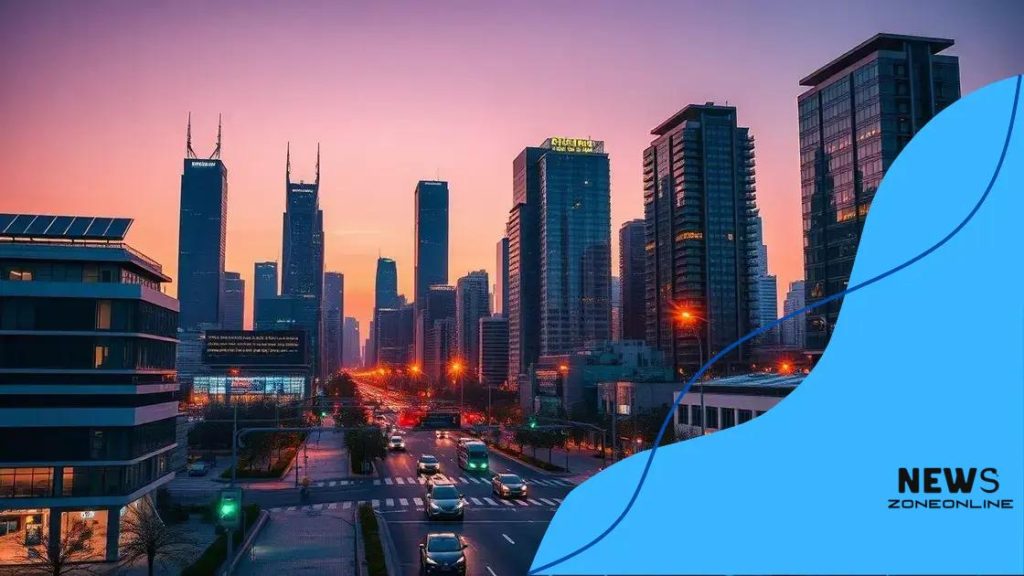The rise of smart cities in Latin America: challenges and opportunities

The rise of smart cities in Latin America focuses on utilizing technology to enhance urban living, improve sustainability, and tackle challenges like traffic congestion and waste management.
The rise of smart cities in Latin America is transforming urban environments by leveraging technology to improve infrastructure and quality of life. But what does this really mean for our day-to-day lives? Let’s explore.
Understanding smart cities and their significance
Understanding smart cities is essential for grasping how urban areas are changing. These cities use technology and data to improve the quality of life for their residents. By integrating advanced systems, cities are aiming for efficiency and sustainability.
What defines a smart city?
A smart city is characterized by its use of digital technology to enhance performance in various sectors. This includes transportation, energy, and communication services. It also encourages active participation from the citizens. Here are a few key elements:
Such characteristics show how smart cities adapt to the needs of their inhabitants. They are not just about technology; they focus on creating a better living environment.
The benefits of smart cities
There are many benefits of developing smart cities. For instance, they can significantly reduce traffic congestion, improve energy efficiency, and enhance public safety. When cities employ smart solutions, they can make informed decisions that lead to better outcomes for all.
These cities foster a sense of community and make it easier for residents to access services. By prioritizing citizen engagement, smart cities allow for two-way communication between governments and their people.
The importance of understanding smart cities lies in recognizing their potential to reshape urban life. These innovations can lead to healthier and more sustainable living conditions. It is crucial for policymakers and citizens alike to engage with these developments actively.
Key challenges facing smart cities in Latin America
Key challenges facing smart cities in Latin America are critical to understand for effective urban planning. While these cities promise innovation and improved living conditions, several obstacles can hinder their development.
Infrastructure limitations
Many Latin American cities struggle with outdated infrastructure. This makes implementing new technologies difficult. Inadequate roads and utilities can lead to inefficiencies, preventing citizens from fully benefiting from smart solutions.
All these factors contribute to the challenges that urban planners face in these growing cities.
Social inequalities
Another significant challenge is social inequality. In many cities, some communities may not have access to the benefits that smart city initiatives promise. This can create a divide, where only a portion of the population benefits from technological advancements.
Bridging this divide is vital. Engaging marginalized communities in smart city projects can encourage inclusivity. However, this requires targeted efforts and funding.
Additionally, not all citizens may have the knowledge or resources to engage with new technologies. Education and digital literacy programs will play a crucial role in overcoming this challenge.
Political and regulatory hurdles
Political instability can also pose challenges to the development of smart cities. Changes in government can lead to shifts in priorities. Moreover, lack of coherent regulations can slow down the implementation of necessary technologies.
These issues highlight the need for strong governance to support the successful rollout of smart urban solutions.
As smart cities in Latin America continue to evolve, addressing these challenges will be crucial. Engaging all stakeholders and ensuring balanced development can pave the way for future success.
Opportunities for innovation and growth

The rise of smart cities in Latin America brings various opportunities for innovation and growth. These cities have the potential to leverage technology to solve urban challenges and improve everyday life for their residents.
Technological advancements
One of the most significant opportunities lies in embracing new technologies. Cities can implement smart traffic systems and energy-efficient buildings to reduce waste and enhance the quality of life. These innovations can streamline urban operations and create more efficient public services.
By investing in these technologies, cities can create environments that support growth and attract new businesses.
Economic growth and job creation
As smart cities expand, they have the potential to stimulate economic growth. New job opportunities will arise as innovative companies look to invest in urban areas. This economic boost can help alleviate poverty and reduce unemployment rates.
Additionally, local startups can flourish by providing solutions tailored to smart city needs. By fostering an ecosystem of innovation and entrepreneurship, Latin American cities can become hubs of technological development.
Moreover, attracting international investments can lead to enhanced infrastructure and improved public services. These changes can offer significant benefits for residents, making the cities more enjoyable and sustainable places to live.
Collaborative partnerships
Building partnerships between governments, private sectors, and communities is vital for the success of smart city initiatives. Collaboration enables sharing of resources and knowledge, fostering a culture of innovation. Public-private partnerships can fund projects that would otherwise be unfeasible.
Sustainable growth comes not just from adopting technology but through working together to create solutions that address specific urban challenges.
Sustainable practices in smart city development
Sustainable practices in smart city development are crucial for ensuring that urban areas grow without harming the environment. These practices not only promote a cleaner city, but they also enhance the quality of life for residents.
Green infrastructure
Implementing green infrastructure is an effective way to promote sustainability. Cities can create green roofs, community gardens, and urban forests. These features improve air quality, reduce heat, and provide habitats for wildlife.
Green infrastructure not only beautifies the city but also makes it more resilient to climate change.
Energy efficiency
Using energy-efficient technologies is vital in smart city development. Cities can benefit from smart grids, LED street lighting, and energy-efficient buildings. These changes reduce energy consumption and lower costs for residents.
Additionally, encouraging the use of renewable energy sources is essential. Solar panels and wind turbines can provide sustainable energy for city buildings and homes. By investing in these technologies, cities can lessen their dependence on fossil fuels.
Waste management and recycling
Effective waste management is another key aspect of sustainability. Cities should promote recycling programs and composting to minimize landfill waste. Educating residents about responsible waste disposal can further enhance these efforts.
By fostering a culture of sustainability, cities can motivate residents to participate in waste reduction initiatives.
Integrating these sustainable practices into smart city development not only addresses environmental issues but also creates a healthier, more vibrant community. As cities continue to grow, focusing on sustainability ensures that future generations will enjoy a cleaner and greener urban environment.
The role of technology in shaping urban landscapes
The role of technology in shaping urban landscapes is vital as cities transition into smart cities. Innovative technologies have the power to transform how we live, work, and interact within urban areas.
Smart transportation solutions
One significant impact of technology is in transportation. Smart traffic management systems can reduce congestion and improve travel times. By utilizing sensors and real-time data, cities can optimize traffic flow and minimize delays for commuters.
These solutions not only enhance efficiency but also contribute to a reduction in carbon emissions.
Data analytics for urban planning
Technology enables urban planners to use data analytics for informed decision-making. This includes analyzing population density, traffic patterns, and resource utilization. With big data, planners can create designs that cater to community needs and ensure sustainable development.
For instance, cities can use data-driven insights to identify areas needing more green spaces or public amenities. This proactive approach leads to more livable and attractive urban environments.
Smart waste management
Another example of technology’s role is in waste management. Smart bins equipped with sensors can monitor waste levels and optimize collection routes. This leads to more efficient disposal processes, saving time and resources.
Such innovations not only streamline operations but also promote environmental responsibility among residents.
As technology continues to develop, its influence on urban landscapes will only grow. The integration of smart solutions into city planning offers a path toward more sustainable, efficient, and livable urban environments.
FAQ – Frequently Asked Questions about Smart Cities in Latin America
What is a smart city?
A smart city uses technology and data to improve public services, transportation, and overall quality of life for residents.
How can technology address urban challenges?
Technology such as smart traffic systems, waste management solutions, and data analytics can help cities manage resources efficiently and improve urban living conditions.
What role do residents play in smart city development?
Residents are crucial for success; their input helps shape smart city initiatives, ensuring that developments meet community needs.
What are some sustainable practices for smart cities?
Sustainable practices include implementing green infrastructure, efficient energy use, and engaging in responsible waste management.





